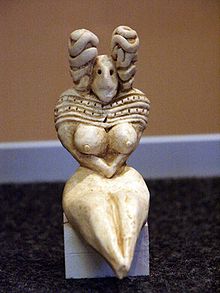Yndusbeskaving
De Yndusbeskaving wie in heechûntwikkele beskaving yn de âldheid (± 3300-1300 f.Kr.), mei in bloeitiid fan 2600–1900 f.Kr. It rûn fan in gebiet lâns de Yndus en de Ghaggar-Hakra rivier, no yn Noardwest-Yndia en diels Pakistan. De Yndusbeskaving waard pas ûntdekt yn de jierren tweintich fan de 20e iuw en is frijwol allinnich út talleaze archeologyske opgravings bekend; dêrneist binne der mar inkele Sumearyske ferwizingen nei in saneamd "Meluhha", dy't hjirop wize koene. De wichtichste archeologyske fynplakken binne Harappa en Mohenjodaro yn Pakistan.


De Yndusbeschaving stiet ek bekend as Harappabeskaving (nei Harappa, de earste opgroeven stêd yn de regio). Benammen yn de Angelsaksyske wrâld wurdt de term Indus-Sarasvatî Civilisation of Sarasvati-Sindhu Civilisation brûkt. Hjirby wurdt ferwiisd nei de Vedische beskaving, bekend út de Vedyske literatuer, dêr't se mei lyksteld wurdt. Dy soe neffens dizze âlde geskriften lâns de Sarasvaty rivier bloeid hawwe, al wit men no de lizzing fan dizze rivier net seker.[1] Neffens guonnens[2] is de Indusbeskaving sa potinsjeel kandidaat as lokus foar it Proto-Dravidysk.
De woartels fan de religy sa't dy no troch de Hindûs belibbe wurdt, lizze yn de Yndusfallei. In beskaving dy't ± 3500 - 1500 foar Kristus bestie út no foar it meastepart Pakistan.
It hindoeïsme hat him benammen om 1000 foar Kristus ûntwikkele. De oarsprong fan it hindoeïsme is te finen 3500 foar Kristus, it begjin fan de Yndusfallei beskaving. De veda’s en oare geskriften fan dizze beskaving ûntwikkele har ta libbenswize dy't wy no noch kenne. Yn it begjin fan de jierren tweintich waarden oerbliuwsels fûn fan in heechûntwikkele beskaving. Archeologen diene opgravings by Mahenjodaro en Harappa yn de Yndusfallei. Op segels fan spekstien waarden religieuze teksten fûn. Op de segels waarden neist teksten ek ôfbylden fûn fan bygelyks in frouljusfiguer dy't in poppe it boarst jout, in Memmegoadinne. Op in oare segel is in man mei krúste skonken te sjen, wat op yogamiditaasje wiist.
Wat wy oer de Yndusfallei beskaving witte, is basearre op materiële oerbliuwsels. De opgravingen yn de Yndusfallei hat de oarsprong fan it hindoeïsme bleat lein.
Bibliografy
bewurkje seksje- Algemiene benadering
- Angot, M. L'Inde classique, Soc. éd. Les Belles Lettres, Paris, 2001 ISBN 2-251-41015-5
- Basham, A.L., The Wonder That Was India, Londen (Sidgwick & Jackson), 1967, siden 11-14. ISBN 0-283-99257-3
- Chakrabarti, D.K., Indus Civilization Sites in India: New Discoveries, Bombay (Marg Publications), 2004. ISBN 81-85026-63-7
- Dani, A.H., A Short History of Pakistan, Karachi (University of Karachi), 19842.
- Farmer Steve, Sproat Richard, and Witzel Michael, The Collapse of the Indus-Script Thesis: The Myth of a Literate Harappan Civilization, EVJS, vol. 11 (2004), issue 2 (Dec) [1]
- Kenoyer, Jonathan Mark, Ancient cities of the Indus Valley Civilization, Oxford - New York (Oxford University Press), 1998. ISBN 0-19-577940-1
- Gupta, S.P., The Indus-Saraswati Civilization: Origins, Problems and Issues, New Delhi (Pratibha Prakashan), 1996. ISBN 81-85268-46-0
- S. Kathiroli - e.a., Recent Marine Archaeological Finds in Khambhat, Gujarat, in Journal of Indian Ocean Archaeology 1 (2004), pp. 141-149.
- Kenoyer, J.M., Ancient cities of the Indus Valley Civilization, Oxford - New York (Oxford University Press), 1998. ISBN 0-19-577940-1
- Lal, B.B., The Earliest Civilization of South Asia (Rise, Maturity and Decline), New Delhi (Aryan Books International), 1997. ISBN 81-7305-107-0
- Lal, B.B., India 1947-1997: New Light on the Indus Civilization, New Delhi (Aryan Books International), 1998. ISBN 81-7305-129-1
- Lahiri, N. (ed.), The Decline and Fall of the Indus Civilization, Londen (Orient Longman Ltd), 2000. ISBN 81-7530-034-5
- Parpola, A., Study of the Indus Script, lezing op 50th ICES Tokyo Session (19 maaie 2005, Tokio).
- Rao, S.R., Dawn and Devolution of the Indus Civilization, New Delhi (Aditya Prakashan), 1991. ISBN 81-85179-74-3
- Shaffer, J.G., The Indus Valley, Baluchistan and Helmand Traditions: Neolithic Through Bronze Age, yn R.W. Ehrich (ed.), Chronologies in Old World Archaeology, Chicago (University of Chicago Press), 19922, I: pp. 441-464, II: pp. 425-446. ISBN 0-226-19447-7
- Witzel, M. and Farmer S., Horseplay in Harappa Frontline, Oct. 10, 2000. [2]
- Witzel, Michael, Indocentrism: Autochthonous visions of ancient India. In: The Indo-Aryan controversy : evidence and inference in Indian history / edited by Edwin F. Bryant and Laurie L. Patton. London & New York : Routledge, 2005: 341-404
- Oer materiële kultuer
- Ardeleanu-Jansen, Alexandra - Die Terrakotten in Mohenjo-Daro. Eine Untersuchung zur keramischen Kleinplastik in Mohenjo-Daro, Pakistan (ca. 2300-1900 v.Chr.), Aken 1993.
- Oer taal en skrift
- Parpola, Asko - Deciphering the Indus Script, Cambridge 1994.
- S. Farmer - R. Sproat - M. Witzel, The Collapse of the Indus-Script Thesis: The Myth of a Literate Harappan Civilization, in EJVS 11 (2004), siden 19-57.
- ↑ J. McIntosh, A Peaceful Realm: The Rise And Fall of the Indus Civilization, Boulder, 2001, p. 24.
- ↑ art. Indus civilization, yn Encyclopedia Britannica. Online edition (2007), A. Parpola, Deciphering the Indus Script, Cambridge, 1994.
| Ofbylden dy't by dit ûnderwerp hearre, binne te finen yn de kategory Indus Valley Civilization fan Wikimedia Commons. |